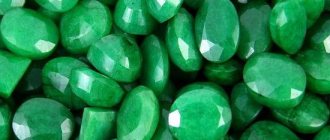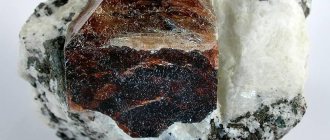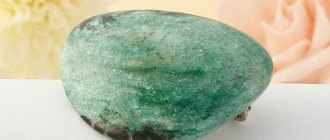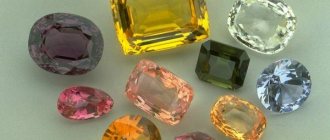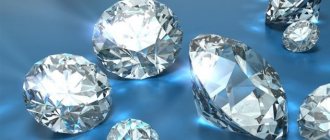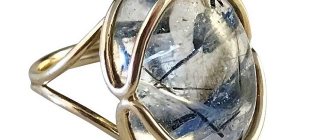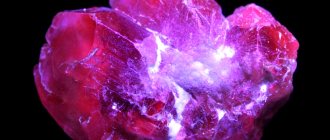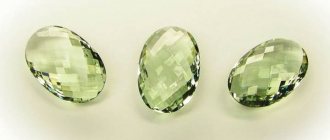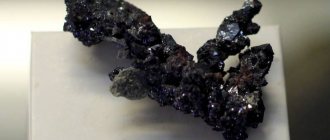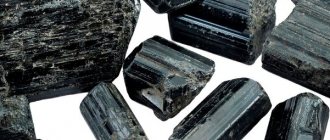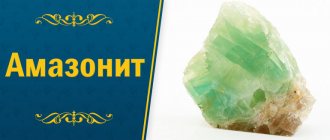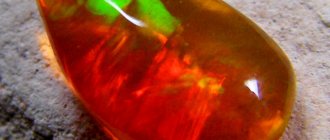| Category | Silicate minerals |
| Title in English | Andalusite |
| Formula | Al2SiO5 |
| Group | Kyanite group |
| Color | Pink, Purple, Yellow, Green, White, Gray |
| Stroke color | White |
| Shine | Glass |
| Transparency | Transparent |
| singonia | Rhombic |
| Hardness | 6,5 — 7,5 |
| Cleavage | Imperfect |
| Density, g/cm³ | 3,12 — 3,18 |
| Kink | Uneven |
| origin of name | This transparent semi-precious stone got its name from the place where it was first found - it happened in Andalusia, a large autonomous region of Spain. |
| Morphology | The stone is most often found in the form of columnar prismatic crystals of considerable size. In addition, there are also columnar and granular aggregates. |
Andalusite is a type of aluminum silicate. The stone is found very often and its properties are similar to other minerals of the silicate group. It is characterized by a high melting point and resistance to acids. Most often, due to these qualities, andalusite is used as a raw material for the refractory and insulating production of fine ceramic materials. Andalusite is used relatively rarely in jewelry, since high-quality crystals are rare, and they are difficult to process.
Andalusite deposits
Previously, andalusite deposits located in Spain were considered the richest, but they have become severely depleted.
Today, deposit development is mostly carried out in Australia, Brazil, Sri Lanka, and the Elbrus region. These regions are the suppliers of high-quality andalusite jewelry crystals. — Advertising —
In addition, there are mines in Canada, the USA, Russia, Germany, and Kazakhstan.
Andalusite deposits are various shales: clayey, carbonaceous-clayey, mica, secondary quartzites.
Helpful information
- Due to its high heat resistance, the stone is widely used for refractory lining.
- Sand obtained after processing stone is used to produce dishes, furniture, and spark plug elements. They are absolutely safe at high temperatures.
- The stone is called "the poor man's alexandrite", but it changes color regardless of the light.
Andalusite, Maltese cross, cross, “Seeing Stone”... Whatever you call it, we are talking about an amazing mineral given to humanity as a talisman. But we must remember: he will help only those who are pure in soul and have no evil intentions.
5 / 5 ( 1 voice )
History of andalusite
The aluminum silicate andalusite was first described at the end of the 18th century by the French mineralogist Delameterrier.
Specimens of the gem were discovered in Andalusia (Spain), and were named after the place of discovery. Natural stones usually form granular aggregates or individual prismatic columnar crystals that can grow to large sizes.
— Advertising —
Andalusites are also often found under numerous synonymous names, including viridines, hard spars, stanzaites, apyres, micaphyllites, and cousinranites.
Where is andalusite mined today?
The mineral in question cannot be called rare. Large deposits of stone are found on every continent and in every country - from Canada to South Africa.
Samples of andalusite for industrial use are mined mainly in the USA, Canada, Czech Republic, Slovakia, Austria, Turkey and Ukraine. In Russia, the Urals and Transbaikalia are especially rich in the mineral.
The most famous deposits of gems for the jewelry industry are located in the Elbrus region.
It is noteworthy that in Spain, the country that discovered andalusite to the world, there are practically no active deposits left.
Physico-chemical characteristics of andalusite
In terms of its chemical composition, andalusite is a complex aluminum-silicon salt with admixtures of iron and manganese oxides, as well as carbonaceous and clayey substances.
The andalusite crystal is thick-tabular, columnar, columnar, or is a granular intergrowth, with an orthorhombic system and imperfect cleavage.
The color palette of andalusites includes mainly warm shades of gray, yellow, brown, golden, orange-brown and pink. Less common are red and dark green stones. But colorless andalusites are a real rarity.
The stone is characterized by pleochroism; it changes its color depending on the angle of incidence of sunlight: yellow-green andalusite becomes reddish-brown or dark red. Yellowish-green luminescence is weakly expressed.
The stone has a glassy luster and is transparent or translucent. Hardness 7.5 on the Mohs scale. The density is 3.12-3.18 g/cm3. Uneven at the break.
The melting point of andalusite reaches 1380 °C.
Associated minerals are corundum, diaspores, muscovites, topazes, pyrophyllites, and rutiles. Alexandrite is the most similar stone to andalusite.
Classification
Andalusite in its structure has two types of aluminum atoms - in coordination 6 and 5. Non-ideal octahedra (octahedrons) consisting of a compound of aluminum and oxygen are parallel to the axis in the form of chains that are connected along the edges. Covalent bonding exceeds ionic bonding.
| IMA (International Mineralogical Association) status | Authorized, "Grandfathered" described before 1959 |
| Nickel-Struntz classification 10th edition (pending revision) | 9.AF.10 |
| Dana Classification 8th Edition - Primary Groups | 52.2.2b.152: Neosilicates precipitated by SiO4 groups and O,OH,F,H2O |
| Hey,s CIM Ref | 15.1 |
Crystallography
| Syngony (crystal type) | Rhombic (pseudo-tetragonal) |
| Class (HM) | mmm (2/m2/m2/m) – irregular pyramid |
| Space group | Pnnm |
| Unit cell volume | A=7.798(7) Å, b=7.9031(10) Å |
| Ratio | a:b:c: = 0.987:1:0.703 |
| Unit cell | V:342.44 Å3 |
| Duality | rare |
| Morphology (elements) | The elements are crystals and columnar compounds having almost square sections, usually elongated in parallel (up to 20 cm). Crystals may be interrupted due to interference with external minerals. |
Chemical composition
Anadalusite is a prismatic anhydrous crystal that is highly resistant to acids.
| Formula | Al2(SiO4)O |
| Formula (MMA - International Mineralogical Association) | Al2SiO5 |
Physical properties
Andalusite is considered a pure mineral that is common in clayey and coal-shale. Occasionally it is found in mica schists.
Transparent green andalusite is considered its most valuable form. Unlike other pleochraean gemstones, where gem cutters try to reduce the multi-colored tones and emphasize the best color, cutting andalusite instead tries to produce a good combination of colors.
| Shine | Vitreous, sub-vitreous, bold |
| Transparency | Transparent |
| Color | Pink, dark red, white, gray, green, yellow, sometimes purple |
| Mohs hardness | 6 ½ — 7 ½ |
| Series | white |
| Density | |
| Split | Excellent/good |
| Fracture | Irregular Subconchoidal |
| Density | 3.13 – 3.21 cm3 (according to measurement results), 3.149 g/cm3 (according to calculation results) |
| Perseverance | brittle |
Production (fields)
Mineral deposits are often not deep, on the mountain slopes of rivers. Since the discovery and description of the mineral, a large number of deposits have appeared in different countries of the world.
Findings of gem-quality crystals are quite rare. In addition to good examples still being mined in Spain, the Minas Geras and Espirito Santo placers in Brazil are considered promising deposits. Interest in them continues after the discovery of a very large and pure crystal weighing 75-100 carats, from which an excellent piece of jewelry was made.
Unique dark blue crystals have already been found in placers in India, Burma and Ceylon.
The most famous andalusite deposits are in the USA (California, Maine, Connecticut and New Mexico), Canada (Quebec), Australia and Russia (Nerchinsk).
Not long ago, crystals of excellent quality up to 20 cm in length were discovered in Uzbekistan.
Green veridite crystals are mined in Sweden, Spain, Austria and China. There have also been several finds of blue andalusite crystals in Belgium.
One of the famous andalusites is kept in Washington at the Smithsonian Museum. This is a brown crystal, weighing 28.3 carats, brought from Brazil.
Industrial mining of andalusite for the production of refractory materials exists in Italy, Germany, Sri Lanka and Brazil.
Featured in the Smithsonian's current public exhibition - Andalusite with quartz, muscovite and biotite.
Types of andalusite
The following varieties are distinguished for andalusite:
- Chiastolits, cross stones or cross stones. This is an opaque variety of the mineral, on the cross section of which, when processed, a dark cross becomes noticeable. Its formation is explained by selective absorption by the stone faces during growth of particles of coal and clay from the accompanying rock. This feature of the stone is indicated by its name, which goes back to the Greek words “hiastos” and “lithos”, meaning “crossed” and “stone”.
- Viridin is a type of andalusite with a high content of manganese oxide. This species is characterized by a rich green-herbaceous hue.
- Titanium andalusite – as the name suggests, contains an admixture of titanium.
Varieties of mineral
Andalusite is presented in three types:
- Chiastolite, or “cross stone,” is formed as a result of the combination of a mineral with clay and coal, and has a brownish-green tint. It is distinguished by the presence of a pattern on the surface that resembles a cross.
- Titanic andalusite is distinguished by the presence of titanium oxide in its composition, which gives the mineral a gray color, which sometimes shimmers with silver shades.
- Viridin is a mineral with a high content of iron and manganese inclusions, used in jewelry. In cross-section, the crystal has a greenish, “grassy” tint with light green (less often yellow) inclusions.
Also read: Cat's eye - magical light inside the crystal
The magical properties of andalusite
Interestingly, andalusite is not a precious or semi-precious stone, but its magical abilities are equal to those of many famous gems.
Andalusite was and remains a popular mineral among sorcerers and magicians who communicate with otherworldly forces. It is also used to achieve a state of trance and enhance psychic abilities. In addition, fortune tellers also use andalusite. According to legends, the famous soothsayer Nostradamus valued this mineral very much, and always had an andalusite jewelry or amulet with him.
It is believed that andalusite is a good helper for everyone who is engaged in comprehending the secrets of life and the universe, trying to comprehend sacred knowledge and facilitating the transition to higher levels of thinking.
The healing properties of chiastolite
The therapeutic properties of stones have been known since ancient times. Traditional medicine still does not recognize the activities of lithotherapists. But now more and more people are beginning to ignore skeptical claims about quackery and harm to health, turning to alternative treatments such as stone therapy.
The mineral andalusite will help overcome insomnia and promote rapid deep sleep.
When used incorrectly, minerals can actually cause harm. But if you know how to handle them, unpleasant consequences can be easily avoided. For example, andalusite is not recommended for frequent use by hypotensive patients, because it lowers blood pressure. But when used wisely, the mineral helps get rid of headaches.
It is not difficult to study the basic properties of andalusite. You just need to understand in what situations he will be able to help and turn to him at this moment.
Don’t forget to remove the talisman so that it gains strength before fighting new troubles.
Andalusite stone: healing properties:
- normalization of the nervous system - increasing stress resistance, getting rid of depression;
- improved sleep – fights insomnia, promotes rapid deep sleep;
- suppression of causeless anxiety;
- improved resistance to pathogens;
- cleansing the body of waste and toxins;
- increasing the absorption of nutrients - prevents the development of vitamin deficiency.
Chiastolite, which is a type of andalusite, is considered a feminine stone. It is often recommended for young mothers to wear, because it is believed to increase lactation.
Branches of application of andalusite
Andalusite spread and became popular during the Middle Ages.
Then the attention of the Knights Templar, who conducted trade relations with the Cordoba Caliphate, was drawn to its unusual subspecies of chiastolite. From there they received yellowish-orange stones, the cut of which had a clearly visible cross pattern with extensions at the ends. Since this particular cross was the symbol of the Templar Order, it quickly became popular among knights to purchase rings and amulets with andalusites. In addition, the gem began to be used in mysterious knightly rituals. Representatives of other church orders also gradually introduced andalusite into their culture. Later, when other varieties of andalusite were discovered, and deposits with high-quality crystals were found, and craftsmen learned to cut the stone, andalusite began to be used in jewelry.
Nevertheless, the majority of mined andalusite today is used for industrial purposes in the production of fine ceramic products.
STONE PROPERTIES AND APPLICATION
- Andalusite is good for melancholic, phlegmatic, and sanguine people.
- For the work of the crystal in magic and lithotherapy, the days of the first quarter of the moon and the 4th and 5th days of the full moon are especially recommended.
- For those who are passionate about yoga, it is recommended to meditate on the stone before solving any problem.
- Chakra - Vishuddha.
The magical properties of andalusite
- The cross could not help but interest the clergy.
- Rosaries, rings, and crosses are made from stone.
- Esotericists appreciated the beauty and magical properties of the gem. It is believed that it facilitates communication with intangible entities, with the spirits of the departed.
- The crystal helps in communicating with the natural world, which includes humans, animals, and plants.
- Uncut stones help keep a cool head in stressful situations.
- Andalusite protects against the evil eye and damage. While in the house, it will protect the home from accidents, thieves, and unwanted guests.
Chiastolite
They believe that the stone will only help for noble purposes.
Andalusite does not accept those seeking enrichment and personal gain.
Andalusite in lithotherapy
According to lithotherapists, crystals are used in the treatment of:
- diseases of the lungs and respiratory system;
- circulatory system, blood vessels;
- immune system;
- hypertension;
- insomnia;
- stress, depression.
We recommend: ANATAZ – a bright representative of rare gems
Contraindicated in diabetes mellitus and lupus erythematosus.
Compatibility with Zodiac and names
Andalusite is friendly and refuses to help anyone. The main thing is that the person is not aggressive or angry. The crystal will try to get away from such an owner - it will simply get lost.
Andalusite's favorite zodiac signs are Libra and Gemini.
Suitable for people with names that begin with “A”, “G”, “K”. Especially suitable for Andrey and Christina.
Andalusite colors
Natural andalusites are characterized by golden, yellow, yellow-green and brown tones in color.
Pink, gray, red, brown stones are less common. The color of andalusite is determined by the impurities that are included in its composition. The stone is characterized by the ability to change color from different angles of view, that is, pleochroism. By turning the sample from side to side, you can enjoy the beautiful play of colors.
Pure colorless specimens of andalusite are extremely rare and are always used for jewelry purposes.
Combinations with other stones
Faceted Andalusite works well as an accent, in jewelry combining lapis lazuli, carnelian or peridot. Andalusite (or its famous variety veridite) will always look great as a center stone in any artistic jewelry (rings, pendants, brooches, cufflinks or necklaces). Due to its ability to change color, andalusite will always work in bright light, as the constant dynamics of color effects will amaze the viewer.
How to care for andalusite
Andalusite is a durable and reliable stone.
It is unpretentious in terms of handling and storage. It is not recommended to leave the mineral in the sun for a long time and expose it to chemicals. To clean jewelry with andalusite, use a soap solution and a soft brush, after which the product is washed with running water and dried.
NUANCES OF CHOICE AND CARE
How to distinguish from a fake
It is better to take the jewelry to a gemologist or jeweler, but there are tips “for home use”:
- You can simply twirl Viridin in your hands - the edges of the crystal will change color.
- It is advisable to examine chiastolite, its part with a cross, grid or diamond pattern under a magnifying glass - the color transitions of natural stone are smooth, soft, the pattern maintains symmetry.
- You can simply scratch the glass with the mineral. Andalusite is harder and should leave a streak on the glass. You shouldn’t be too zealous; you can crush the “cutting” edge of the crystal.
The price per gram may vary depending on the size of the stone, its cut, purity and location of extraction.
Over the past 10 years, the price of cut andalusite has increased 70 times.
| Carat weight | Country of origin | Type of cut | approximate price |
| 1,6 | Brazil | marquis | 6200 |
| 0,3 | Sri Lanka | circle | 1200 |
| 3,65 | Brazil | a drop | 9900 |
Authentication
Proper care of the gem
Crystal is not fussy to care for, but it also needs care:
- Rinse in warm soapy water when soiled, then rinse with running clean water.
- Aggressive liquids are not recommended; a regular mild shampoo works well.
- It is better to store jewelry in a separate case or simply in a gripper.
If a stone is used for magical purposes, it must be regularly cleansed of “energetic dirt”. To do this, rinse the jewelry in running water and place it in table salt.
We recommend: RHODONITE - the beauty of a bygone era
Salt is a powerful energy purifier. A few hours “on the salt beach”, rinsing the crystal in water - and it is again ready to protect the owner.
Throw away the used salt: it has absorbed negativity from the stone.
Andalusite and zodiac sign
Andalusite is universal and gets along well with representatives of absolutely all zodiac signs. The stone is more sensitive to the intentions of its owner and his character and inclinations. Thus, it is believed that anyone who plans some evil deed or decides to get rich dishonestly with the help of andalusite will lose the stone or amulet.
The meaning of the stone for a person
Andalusite has enormous energy, perhaps due to its natural cross, which is capable of maintaining the integrity of the owner’s aura. The stone should be used by extroverts - people whose line of work is related to people and is aimed at providing assistance.
These are doctors, rescuers, priests, military (but in peacetime, soldiers are not recommended to wear a talisman ). The special influence of the cross on those who are associated with plants and animals is noted: gardeners, field farmers, veterinarians.
Prices for andalusite products
Andalusites of high jewelry quality are quite rare, they are difficult to process, and therefore are not particularly popular among jewelers. However, the price of jewelry andalusite is constantly growing and has increased significantly over the past few decades. So, today a small andalusite of jewelry quality is estimated at 15-25 dollars per carat. But the price for high-quality Brazilian andalusites of an unusual pink-green color with pronounced pleochroism starts at $250-300 per carat, which is comparable to high-quality chrysoberyl. The average weight of such a cut stone rarely exceeds 5 carats, and the cut is round, oval or teardrop-shaped emerald.
Stone care
Despite its hardness and fire-resistant qualities, jewelry made from andalusite or its subspecies must be protected from sharp impacts that can damage the surface. The stone can be safely washed with warm water and mild soap and rubbed with a cloth. Under no circumstances should you use any household chemicals for cleaning. It is better to take it to a workshop once a year to clean the metal fastening of the stone.
Andalusite is best stored with adularia, maintaining the connection between the earth and moon stones.
Interesting facts about andalusite:
- A talisman or amulet with andalusite is suitable for all people associated with mental activity. It is recommended to purchase it for a doctor, scientist, theologian, monk and priest. The mineral is also the patron saint of the military during battles and battles; it is not recommended to wear it during peacetime.
- Due to its pronounced pleochroism, andalusite was once often called “the poor man’s alexandrite.” Unlike the latter, turning at a different angle is enough to change the shade of andalusite, while alexandrite needs a change in lighting.
About pilgrims, crusaders and weeping fairies?
But the iridescent color of andalusite can be the envy of many stones with triple pleochroism. In addition, andalusite does not require a change in lighting to change the color of the facet. It is enough to twirl the stone in your hand, and you will be enchanted by the play of color and light of the “poor man’s alexandrite”.
Its brother, chiastolite, has a long history. Correctly saw a piece of chiastolite, and on the cut you will see a cross - single or double.
These stones were carried by crusaders and simple monks. Pilgrims to the Holy Sepulcher took a “cross stone” on the road, or put on a ring with a miraculous symbol of Christianity.
The Knights of the Order of Malta wore rings and amulets made of chiastolite. Therefore, the stone was often called the “Maltese cross” (maltesite).
Stones with a double cross were called “tears of fairies.” Legend says that the fairies, having learned about the crucifixion of Jesus, wept bitterly. Their tears, falling on the stones, turned into crosses.
Origin of name ?
Andalusite was studied and named in 1798.
The English name of the mineral is Andalusite.
In addition to the official names, you can find the following names:
- hard spar;
- mycaphyllite;
- Shizeilitis.
First discovered in Spain, Andalusia.
Origin and location
A typical mineral of contact metamorphism of clayey rocks (hornfels); found everywhere in the form of small crystals.
Andalusite is a relatively common mineral found primarily in metamorphic rocks. According to Turner, it is characteristic of the hornblende-hornfels (associated with muscovite, biotite and quartz) and pyroxene-hornfels (associated with cordierite, orthoclase, quartz, biotite and plagioclase) facies of contact metamorphism. According to Semenenko, the mineral is formed in aluminosilicate rocks during their metamorphism: thermal contact (high-temperature stage hornfels) and migration-contact (hydrothermal-pneumatolite) - mica-staurolite-andalusite schists and andalusite-corundum aluminoquartzites.
Healing and magical powers
Like many other minerals, andalusite is considered healing. It affects the human nervous system and can positively influence the healing process in diseases such as:
- nervous stress;
- migraine;
- depression;
- psychological disorders.
It has the ability to stop the development of fungal diseases; it is used to treat the lungs and bronchi. The gem strengthens the immune system, especially in older people.
The healing effects of the stone can influence metabolism, normalizing metabolism. In this sense, the mineral can be considered contributing to the acquisition of a slender figure. Like other stones for weight loss - turquoise, onyx, coral, agate, topaz - it is very effective.
Andalusite is a rare, beautiful stone that exudes powerful energy. It is popularly considered the strongest magic crystal. With its help, ancient priestesses turned to the gods and predicted fate. They constantly wore amulets and amulets made of crystal, and with its help they even fell into a trance. The stone is also considered as a guide to the other world, helping to contact spirits.
Another purpose of it is the ability to reveal the strengths and courage of a person, making him brave and strong-willed.
Price in stores
Jewelers paid attention to this semi-precious stone not so long ago, considering its unusual color scheme. To make it open as much as possible, you should wear it in bright light.
The price of the product depends on the material itself, size and cut: pay attention to color, transparency and the presence of a cross-shaped pattern. These parameters make jewelry more expensive.
Approximate prices in stores:
- cut stone without frame - from 800 to 2750 rubles;
- earrings with a cross inside a mineral - from 2700 to 5000 rubles, bracelets - from 5600 rubles, rings and pendants - from 2500 rubles;
- beads - above 6,000 rubles.
The stone will be a good gift for humanists and altruists, enhancing the positive energy of such people and helping them in their life calling.
How to spot a fake
Quite often, instead of natural andalusite, the buyer is offered colored glass. The signs by which you can distinguish an original stone from a fake depend on the type of mineral:
- A real chiastolite has a symmetrical diamond-shaped, cross-shaped or checkerboard pattern, with the shades of the pattern smoothly transitioning into the main tones.
- The authenticity of viridin is confirmed by the effect of pleochroism. If the stone is slowly rotated around its axis, it will change color.
- The gem has increased hardness. If you run a stone across the glass, it will leave a mark in the form of a scratch.
Andalusite, like all stones of natural origin, takes a long time to heat up compared to synthetic materials. To check, just put the gem in your palm and feel its pleasant coolness.
